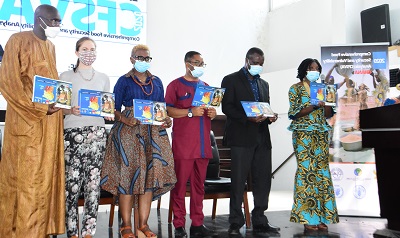
About 3.6 million people in the country (12 per cent of the population) are food insecure, the 2020 Comprehensive Food Security and Vulnerability Analysis (CFSVA) survey has found.
Majority of the food insecure, constituting 2.8 million (78 per cent of the sample households), live in the city while the 0.8 million, constituting 22 per cent of the sample households, live in the rural areas.
Per the report, food insecurity does not mean there is hunger in Ghana, but that people do not have food at the right time, price and place with the required nutritional value.
It defined food insecurity as the lack of consistent access to enough food for an active and healthy life, and food security as the physical and economic access to sufficient, safe and nutritious food by all people at all times to meet their dietary and food preferences for an active and healthy life.
The survey conducted by the Ghana Statistical Service between November and December 2020covered 65,309 households across all the districts of the 16 regions of the country.
It was funded by the Government of Ghana and World Bank and supported by the World Food Programme and the Food and Agriculture Organisation.
The report found that Upper East (48.7 per cent), North East (33.0 per cent) Northern (30.7 per cent), Upper West (22.8 per cent), Savannah (22.6 per cent), Ahafo (17.3 per cent), Bono East (16.7 per cent) and Western North (13.1 per cent) were the most insecure food areas of the country.
The most food secured areas the report mentioned were Greater Accra (3.5 per cent), followed by Central Region (3.8 per cent), Western (5.1), Ashanti (6.2 per cent), Eastern (7.9 per cent), Oti (8.0 per cent), Volta (9.9 per cent) and Bono (12.2 per cent).
Specifically, the report identified Kassena-Nankana (78.8 per cent), Karaga (75.9 per cent), Builsa South (74.5 per cent), Tatale (68.4), Bolgatanga East (66.3 per cent), Kumbungu (61.2 per cent) and Jirapa (61.0 per cent), Chereponi (60.3), Tempane (59.2 per cent) and Bongo (57.3 per cent) as the districts with high prevalence of food insecurity.
The report said about 90 per cent of households said they experienced shock last year, with 63 per cent attributing the shocks to COVID-19, 34 .1 per cent attributed the shock to high food prices and 21.6 attributed the shock to late rain and drought.
Among others, the survey recommended the development of all-year-round irrigation and mechanisations schemes to support large and small-scale farming to engender all-year food production.
“The current policy on subsidy on agricultural inputs under the Planting for Food and Jobs programme should be re-packaged to target food and cash crop farmers and agro-pastoralists in food-insecure areas,” it said.
Launching the report, the Deputy Government Statistician, Dr Faustina Frempong-Ainguah, said the latest CFSVA was the fourth to be produced by the GSS, with the first one developed in 2004.
She said the objectives of the study were to determine the prevalence of food insecurity in Ghana, determine how many people were food insecure and the reasons for insecurity and assess the trends over the waves of food insecurity.
The Representative and Country Director of WFP, Babara Tulu Clemens, said the survey would help inform policy on how to improve food security in the country.
The FAO Country Representative, Ndiaga Gueye, said food challenges on the continent had been compounded by COVID-19 pandemic and called on all stakeholders in the country to support the food systems in the country to promote food security.
BY KINGSLEY ASARE & CECILIA LAGBA







